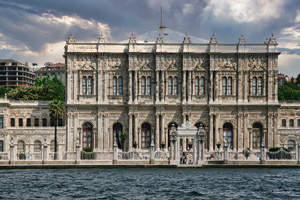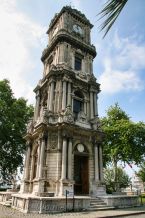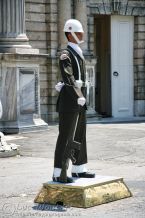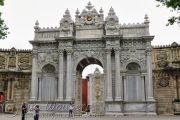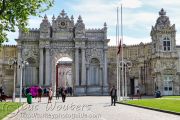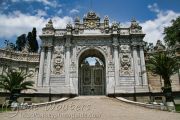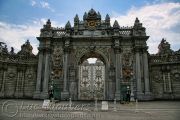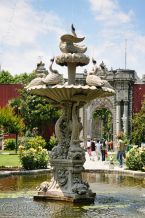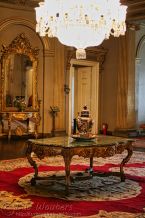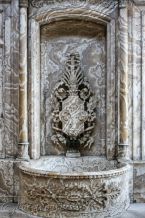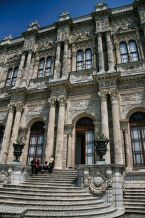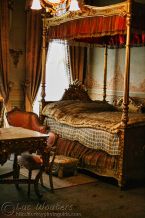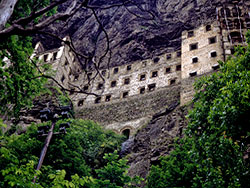Dolmabahçe Palace is the largest and grandest of the Ottoman palaces on the Bosphorus.
Historical Background
The name Dolmabahçe (filled-in garden) comes from the Turkish dolma which means filled and bahçe meaning garden. It refers to the fact that the site was reclaimed from the sea in the 17th century to create a large royal garden, while before it was an inlet on the European shore of the Bosphorus and was used as a harbour for the anchorage of the Ottoman fleet. In the park, a number of pavilions and kiosks were built that eventually evolved in a palace. Sultan Mahmut II preferred it above the crowded confınes of Topkapı Palace and moved his residence here. His son Abdülmejid, the thirty-first Ottoman sultan and great reformer, decided to build the much larger and more luxurious palace that we can visit today.
Chief architect of the Dolmabahçe Palace was Nikoğos Balyan who worked in collaboration with his father Karabet Balyan. The Balyans were a distinguished Armenian family of architects who were responsible for the construction of several mosques and palaces during the second half of the 19th century. Construction started in 1843 and was completed in 1854, but Abdülmejid and his family did not move in until 1856, thereby abandoning Topkapı Sarayı that had been the imperial residence for almost four centuries. The construction of the palace costed 35 tons of gold, which corresponded to approximately a quarter of the yearly tax revenue. The cost of maintenance, with its more than 5,000 servants, was also substantial and contributed for a large part to the deterioration and eventual bankruptcy of the Ottoman economy.
Dolmabahçe Palace served as the principal imperial residence for all the latter sultans except Abdülhamit II, whose distrust of the Ottoman navy and the proximity of the palace to the waterfront, made him decide to move his residence to the more inland Yıldız Sarayı. After the end of the empire, Atatürk used it as his presidential residence when he was in Istanbul. He died here on 10 November 1938 at 9:05 AM.
Sights & Photos of Dolmabahçe Palace
The most impressive view on the palace is its seaside façade of white marble, with the edifice itself 284 metres in length on a walled quay 600 metres long. The palace occupies a ground area of 45,000 square metres and consists of a great imperial hall in the centre, flanked by two main wings, the selamlık with the state rooms and royal apartments on one side and the harem on the other side.
The first building of the palace complex is a neoclassical mosque on the seaside, Dolmabahçe Camii, that was commissioned by Bezmialem Valide Sultan, the mother of Abdülmejid and a patron of arts and literature. Construction of the mosque was completed by her son, shortly after her death in 1853. Architects were father and son Balyan who also designed Dolmabahçe Palace.
The next building after the mosque is the baroque clocktower. It was commissioned by Abdülmejid's son Abdülhamit II in 1890 and was completed in 1895, architect was Sarkis Balyan, the younger brother of Nikoğos. The height of the clocktower is approximately 27 m and its ground area is 8.5 x 8.5 m. There are four clocks on the sides, produced by master clockmaker Johann Meyer who at the time was working for the company of Jean-Paul Garnier.
Entrance to Dolmabahçe Palace is provided by a total of ten ornate gates, of which the Treasury Gate and Sultanate Gate are the most important. Both gates are highly decorated and adorned with a tuğra, displaying the signature of sultan Abdülmejid. The palace gardens were landscaped in a European style with geometric arrangements, garden ponds, vases, sculptures, etc. Rare plants from Asia, Europe and the Americas were used to create a splendid collection.
https://www.turkeyphotoguide.com/dolmabah%C3%A7e-palace#sigProIde56f52cb55
The palace interior is the work of the French decorator Charles Séchan, who also designed the Paris Opera and the Théâtre Royal de la Monnaie in Brussels. This is why the decor and furniture of Dolmabahçe Palace strongly resemble the French palaces and mansions of that period. There are a total of 285 rooms, 43 large salons, six balconies, six hamams, and 68 toilets distributed over three storeys.
The furnishings of the palace include 4,455 square metres of hand-woven Hereke carpets, 156 clocks, fireplaces and chandeliers in Bohemian and Baccarat crystal. The chandeliers account to a total of 36, the largest being the 4.5 ton massive giant hanging in the Ceremonial Hall, the largest chandelier in the world. An eyecatcher is certainly the ornate stairway that leads up from the Salon of the Ambassadors with its balusters made of crystal. The harem area consists of eight interconnected apartments for the wives and concubines of the sultan and for his mother. Each of the apartments has its own bathroom.
https://www.turkeyphotoguide.com/dolmabah%C3%A7e-palace#sigProId8c6db9d1ba
Travel Information & Travel Tips
Dolmabahçe palace is located on the European shore of the Bosphorus, between the Beşiktaş and Kabataş piers. It is a ten minute walk from Kabataş pier, tram, and funicular stations.

